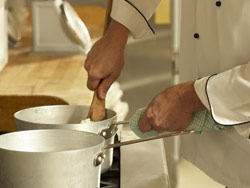

In saucepan, bring 2 to 3 inches of water to boil. If group is large, just demonstrate while explaining process. Poaching Activity: If group is small, allow participants to participate in activity as you explain the process.

The white should not have streamers, and the yolk should be cooked to where it begins to solidify. A poached egg should have a firm, tender white well around the thickened, unbroken yolk. Have little tendency to spread away from the yolk. A high-quality egg, with its abundance of thick white, will
#CULINARY FUNDAMENTALS POACHING FULL#
A full rolling boiling would break apart the structure of the food. This allows the protein in the food to coagulate without toughening it. The temperature is then adjusted so that bubbles form on the bottom of the pan but don’t break the surface. Poaching is done by heating the cooking liquid to a simmer before slipping the food in very gently.Poaching is a good way to cook without adding fat to the dish. The poaching liquid adds taste to the food and then can be used as the base for a sauce. The food doesn’t get stirred or disturbed too much so it doesn’t fall apart or break up. Poaching is a fast way to cook tender protein foods like eggs or fish.Objective 2: Identify and demonstrate poaching, simmering, boiling, and steaming.

Food that is steamed cooks quickly with very little loss of nutrients. It is an ideal method for cooking seafood, vegetables, and other delicate food items. o Steam carries much more heat than boiling water yet steaming is a very gentle way to cook foods. Steaming o Once water is heated past boiling point (212☏) it turns into steam. o This is the method least likely to be used in cooking because it can destroy some delicate foods with its active action and the high temperature would toughen some foods like meat, fish, and eggs. Boiling is the hottest of the three techniques (212☏). o Simmering is the standard method for preparing soups, stocks and starchy items such as potatoes. o Food that is simmered cooks evenly because it stays at a constant temperature due to being surrounded by water. Bubbles will form and gently rise to the surface of the pan, but the water is not at a full rolling boil. Simmering is done at hotter temperatures than poaching (185º - 205º F). Poaching is usually used for very delicate food items such as eggs or fish. Ask the class: Which is hotter? Liquid that can poach food or liquid that can simmer food? Poaching is done by heating the water to a low temperature (160˚ - 180˚ F) where the liquid in the pan is hot but not bubbling at all, although some small bubbles may form at the bottom of the pot. Each method cooks food by immersing it in a liquid, usually water or stock. Time: ġ0 minutes Poaching, simmering and boiling are different stages of the same cooking process. Objective 1: State the similarities and differences between poach, simmer, boil, and steam (moist heat cooking methods) and when to use them.

Pot for corn chowder (see recipe on pg 8). Taste foods that have been prepared using one or more moist cooking methods. Identify and demonstrate poaching, simmering, boiling, and steaming. State the similarities and differences between poach, simmer, boil, and steam, (moist heat cooking methods) and when to use them.


 0 kommentar(er)
0 kommentar(er)
